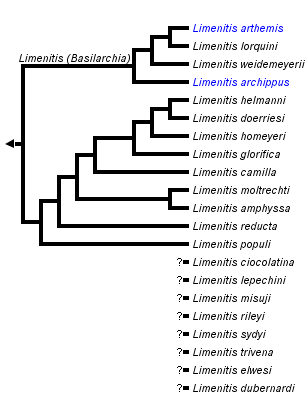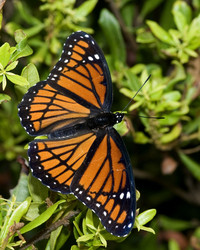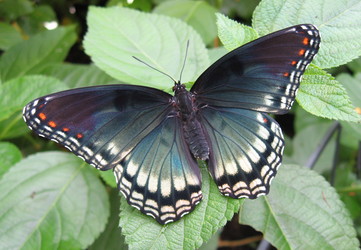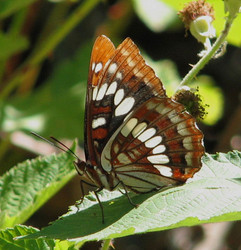Limenitis
Andrew V. Z. Brower


This tree diagram shows the relationships between several groups of organisms.
The root of the current tree connects the organisms featured in this tree to their containing group and the rest of the Tree of Life. The basal branching point in the tree represents the ancestor of the other groups in the tree. This ancestor diversified over time into several descendent subgroups, which are represented as internal nodes and terminal taxa to the right.

You can click on the root to travel down the Tree of Life all the way to the root of all Life, and you can click on the names of descendent subgroups to travel up the Tree of Life all the way to individual species.
For more information on ToL tree formatting, please see Interpreting the Tree or Classification. To learn more about phylogenetic trees, please visit our Phylogenetic Biology pages.
close boxIntroduction
A holarctic genus which includes four North American species and a number of Eurasian species, the taxonomy of which may be somewhat oversplit given the high degree of hybridization and intraspecific variation exhibited among the North American representatives.
Discussion of Phylogenetic Relationships
The above phylogenetic hypothesis is based on the combined mtDNA + Ef-1 alpha sequence-based phylogenetic analysis of Mullen (2006). The two genes in Mullen's data support alternate positions for L. populi (mtDNA places it at the base of the North American clade), suggesting that the reciprocal monophyly of Old and New World groups implied here is not stable.
Nomenclature and synonymy
Basilarchia is the name used by some authors for the North American species. These represent a distinct clade relative to the Palearctic Limenitis (Mullen 2006), but may render the Old World remainder paraphyletic.
References
Mullen SP. 2006. Wing pattern evolution and the origins of mimicry among North American admiral butterflies (Nymphalidae: Limenitis). Molecular Phylogenetics and Evolution 39: 747-758.
Prudic, K. L. and J. C. Oliver. 2008. Once a Batesian mimic, not always a Batesian mimic: mimic reverts back to ancestral phenotype when the model is absent. Proceedings of the Royal Society Series B 275:1125-1132.
Tuzov VK, Bogdanov PV, Devyatkin AL, Kaabak LV, Korolev VA, Murzin VS, Samodurov GD, and Tarasov EA. 1997. Guide to the butterflies of Russia and adjacent territories (Lepidoptera, Rhopalocera). Pensoft, Sofia.
Title Illustrations

| Scientific Name | Limenitis archippus |
|---|---|
| Location | N. Topsail Island, North Carolina, USA |
| Specimen Condition | Live Specimen |
| Source | Vivid Beauty |
| Source Collection | Flickr |
| Image Use |
 This media file is licensed under the Creative Commons Attribution-NonCommercial-NoDerivs License - Version 2.0. This media file is licensed under the Creative Commons Attribution-NonCommercial-NoDerivs License - Version 2.0.
|
| Copyright | © 2006 Marty DeAngelo |
| Scientific Name | Limenitis arthemis |
|---|---|
| Location | southeastern USA |
| Specimen Condition | Live Specimen |
| Source | Red-Spotted Purple (Limenitis arthemis) |
| Source Collection | Flickr |
| Image Use |
 This media file is licensed under the Creative Commons Attribution-NonCommercial License - Version 2.0. This media file is licensed under the Creative Commons Attribution-NonCommercial License - Version 2.0.
|
| Copyright | © 2008 poppy2323 |
| Scientific Name | Limenitis lorquini |
|---|---|
| Location | Nutmeg Trail (Par Course), Brooktrails near Willits, California, USA |
| Specimen Condition | Live Specimen |
| Source | Lorquin's Admiral |
| Source Collection | Flickr |
| Image Use |
 This media file is licensed under the Creative Commons Attribution-NonCommercial-ShareAlike License - Version 2.0. This media file is licensed under the Creative Commons Attribution-NonCommercial-ShareAlike License - Version 2.0.
|
| Copyright | © 2006 Larry |
About This Page

Middle Tennessee State University, Murfreesboro, Tennessee, USA
Correspondence regarding this page should be directed to Andrew V. Z. Brower at
Page copyright © 2009
 Page: Tree of Life
Limenitis .
Authored by
Andrew V. Z. Brower.
The TEXT of this page is licensed under the
Creative Commons Attribution License - Version 3.0. Note that images and other media
featured on this page are each governed by their own license, and they may or may not be available
for reuse. Click on an image or a media link to access the media data window, which provides the
relevant licensing information. For the general terms and conditions of ToL material reuse and
redistribution, please see the Tree of Life Copyright
Policies.
Page: Tree of Life
Limenitis .
Authored by
Andrew V. Z. Brower.
The TEXT of this page is licensed under the
Creative Commons Attribution License - Version 3.0. Note that images and other media
featured on this page are each governed by their own license, and they may or may not be available
for reuse. Click on an image or a media link to access the media data window, which provides the
relevant licensing information. For the general terms and conditions of ToL material reuse and
redistribution, please see the Tree of Life Copyright
Policies.
- First online 07 November 2006
- Content changed 09 June 2009
Citing this page:
Brower, Andrew V. Z. 2009. Limenitis . Version 09 June 2009 (under construction). http://tolweb.org/Limenitis/70371/2009.06.09 in The Tree of Life Web Project, http://tolweb.org/











 Go to quick links
Go to quick search
Go to navigation for this section of the ToL site
Go to detailed links for the ToL site
Go to quick links
Go to quick search
Go to navigation for this section of the ToL site
Go to detailed links for the ToL site